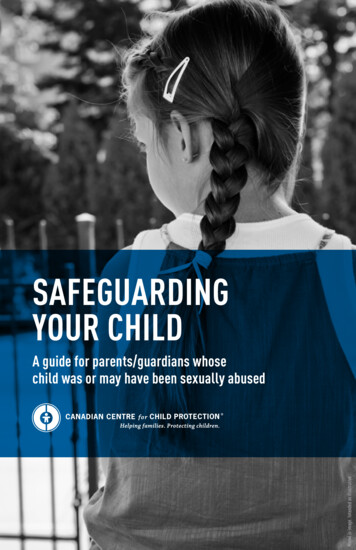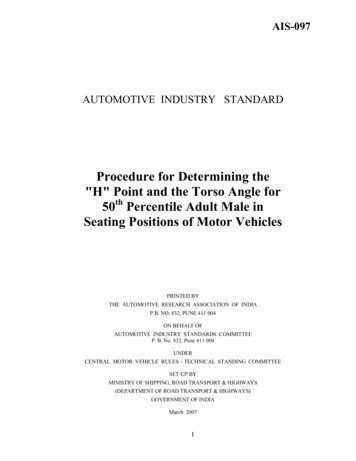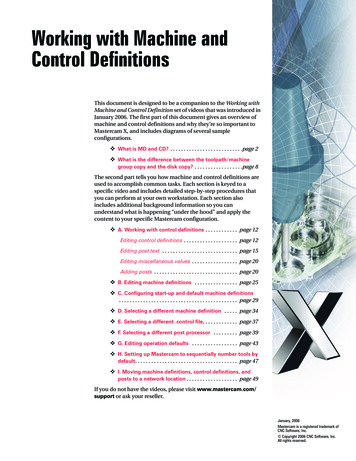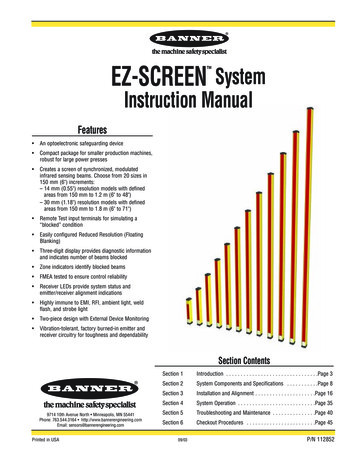
Transcription
WORKER HEALTH AND SAFETYMachine safeguardingat the point of operationA guide for finding solutionsto machine hazardsOregon OSHA
Machine safeguardingat the point of operationA guide for finding solutionsto machine hazardsAbout this guide“Machine safeguarding at the point of operation” is an Oregon OSHAStandards and Technical Resources publication.Piracy notice:Reprinting, excerpting, or plagiarizing this publication is fine withus as long as it’s not for profit! Please inform Oregon OSHA of yourintention as a courtesy.
Table of ContentsThe importance of machine safeguarding.4Portable jigsaw. 31Abrasive wheel grinder .6Power press. 32Horizontal band saw.9Power press brake. 36Vertical band saw. 10Power roll forming and bending machine. 39CNC turning machine.11Radial-arm saw.40Compacting and baling equipment. 13Robots. 41Cut-off saws. 15Belt sander. 42Drill press . 17Disk sander. 43Ironworker. 18Scroll (jig) saw. 45Jointer. 19Shaper/Router.46Metal lathe. 20Shear. 47Wood lathe. 22Table saw. 49Milling machine. 23Power-transmission apparatuses. 51CNC router and cutting tables. 24Lockout/Tagout. 53Planer. 26Risk Reduction Hierarchy. 54Plastic injection molding machinery. 27Training guidelines. 55Portable abrasive grinder. 28Basic safety principles. 56Portable belt sander. 29Glossary of terms. 57Portable circular saw. 30Oregon OSHA Services. 583
The importance of machine safeguardingMost of us have heard the adage about how machinery doesn’t discriminate between product andpeople – it will do the same to both. Many people discover this through unfortunate means: aninjured machine operator sharing the details of his or her accident or a family member reflecting onthe circumstances that took a loved one.Recent statistics thatsupport the concernAbout this guideThis guide focuses on point-of-operation hazards andsafeguarding methods and offers a comprehensivelook at equipment and machinery commonly foundin various Oregon workplaces. It does not specifyall machine guarding requirements or all types ofmachinery or equipment. The reference sectionaddresses typical hazards and guarding solutionsrelated to power transmission devices, lockout/tagout, and general safety principles for operating ormaintaining machines and equipment.NationalContact with objects and equipment (caught in, on,or under equipment or machinery only) More than 690 fatalities per year More than 137,600 lost workday injuries per year 1,400 amputations per yearOregonContact with objects and equipment (caught in andstruck by/against)This guide also refers to many American NationalStandards. The American National Standards Institute(ANSI) publishes voluntary consensus standardson the care and use of machinery. ANSI standardsprovide guidance for complying with Oregon OSHAstandards. ANSI standards are sometimes incorporatedinto Oregon OSHA regulations and employers areaccountable for complying with the version specified.Oregon OSHA generally recommends, however, thatemployers follow the most recent ANSI standards.Of course, all original equipment operating manuals(OEMs) and other manufacturer suggestions must bestrictly adhered to. 13 compensable fatalities per year 29 percent of all fatalities 4,120 accepted disabling injuriesMachines with moving parts and workers who operatethem have an uneasy relationship. Machines makeworkers more productive and enable them to formand shape material in ways that would be impossiblewith hand tools. Technology can make machinessafer, but as long as workers need machines to helpthem process material – to cut, shear, punch, bend, ordrill – they will be exposed to moving parts that couldharm them. Much of the danger occurs at the point ofoperation, where the work is performed and where themachine cuts, shears, punches, bends, or drills.In addition to ANSI, the International Organization forStandardization (ISO) standards provide requirementsfor personnel safety in the design, construction, andintegration of machinery. ISO standards are voluntary.4
Oregon OSHA standards related to machinery and machine guardingConstruction Division 3/Subdivision E, Personal Protective andLife Saving Equipment Division 3/Subdivision I, Tools – Hand and PowerGeneral Industry Division 2/Subdivision I, Personal ProtectiveEquipment Division 2/Subdivision J, General EnvironmentalControls (Lockout/Tagout) Division 2/Subdivision N, Material Handling andStorage Division 2/Subdivision O, Machinery and MachineGuarding Division 2/Subdivision P, Hand and PortablePowered Tools Division 2/Subdivision R, Special Industries(sawmills, pulp and paper mills, etc.) Oregon OSHA Program Directive A-280, NationalEmphasis Program on AmputationsAgriculture Division 4/Subdivision I, Protective Equipment Division 4/Subdivision J, Work Environment(Lockout/Tagout) Division 4/Subdivision N, Material Handling Division 4/Subdivision O, Equipment Guarding Division 4/Subdivision P, Small ToolsForest Activities Division 7/Subdivision D, Personal ProtectiveEquipment and Programs Division 7/Subdivision H, Machines Used in ForestActivitiesOregon fatalitiesOperator pulled into a machine by a moving beltWorker caught in an irrigation spoolLathe operator hit by rotating bar stockOperator caught in keyed shaft (loose-fitting shirt contributed)Worker caught in a glue line conveyor5
Abrasive wheel grinderAbrasive wheels and grinding machines come in many styles, sizes, and designs. Both bench-style andpedestal (stand) grinders are commonly found in many industries. These grinders often have eithertwo abrasive wheels or one abrasive wheel and one special-purpose wheel such as a wire brush,buffing wheel, or sandstone wheel.These types of grinders normally come with the manufacturer’s safety guard covering most of thewheel, including the spindle end, nut, and flange projection. These guards must be strong enough towithstand the effects of a bursting wheel. In addition, a work rest and transparent shields are oftenprovided.Tool restDEWALT Industrial Tool Co.Exposed spindle end, flange, and nut. No tool/workrest.HazardIn addition, the wheels found on these machines(abrasive, polishing, wire, etc.) often rotate at severalthousand revolutions per minute. The potential forserious injury from shooting fragments and the rotatingwheel assemblies (including the flange, spindle end,and nut) is high. To ensure that grinding wheels aresafely used in your workplace, know the hazards andhow to control them.Bench-style and pedestal grinders create specialsafety problems due to the potential of the abrasivewheel shattering; exposed rotating wheel, flange, andspindle end; and a naturally occurring nip pointthat is created by the work rest. This is in additionto such concerns as flying fragments, sparks, aircontaminants, etc. Cutting, polishing, and wirebuffing wheels can create many of the samehazards.SolutionAbrasive wheels used on bench and pedestal grindingmachines must be equipped with safety guards. Thesafety guard encloses most of the wheel – coveringthe flange, spindle end, and nut projection – whileGrinding machines are powerful and designed tooperate at high speeds. If a grinding wheel shatterswhile in use, the fragments can travel at more than 300miles per hour.Wherever the natureof the work requirescontact with thewheel below thehorizontal planeof the spindle, theexposure must notexceed 125 degrees.This exposure beginsat a point not morethan 65 degreesabove the horizontalplane of the wheelspindle.6
allowing maximum exposure of the wheel periphery.The exposure of the wheel should not exceed 90degrees or one-fourth of the periphery (see diagramon Page 6). Because the safety guard is designed torestrain the pieces of a shattered grinding wheel,the distance between the safety guard and thetop periphery of the wheel must not be more than1/4-inch. If this distance is greater because of thedecreased size of the abrasive wheel, then a “tongueguard” must be installed to protect workers from flyingfragments in case of wheel breakage. This tongueguard should be adjustable to maintain the maximum1/4-inch distance between it and the wheel.An adjustable work rest must also be installed andmaintained at a maximum clearance of 1/8-inchbetween it and the face of the wheel.Spindle guardIn addition to offering a stable working position, thissmall clearance must be maintained to prevent theoperator’s hands or the work from being jammedbetween the wheel and the rest, which may causeserious injury or the wheel to break.Tool restTongue guard Proper exposure angle (90 degrees) Adjustable tongue guards (1 4-inch) Adjustable tool/work rest (1 8-inch)Plastic glass (Plexiglas) shields are optional. They are not a substitutefor eye and face protection and are not included as a part of theguard (unless they are adjusted accordingly and have strength equalto that of the safety guard).All abrasive wheels must be closely inspected andring-tested before mounting to ensure that they arefree from cracks or other defects. Wheels should besuspended from the center mounting hole and tappedgently with a light, nonmetallic instrument. A stableand undamaged wheel will give a clear metallic toneor “ring.” If a wheel sounds dead or dull, it may becracked. Do not use it. This is known as the ring test.The spindle speed of the machine must also bechecked before mounting the wheel to be certain thatit does not exceed the maximum operating speedmarked on the wheel.Always follow the manufacturer’s recommendations.ReferencesGeneral Industry Oregon OSHA Division 2/Subdivision O,1910.215Construction Oregon OSHA Division 3/Subdivision I,1926.300(b)(7) & 1926.303Agriculture Oregon OSHA Division 4/Subdivision O, OAR437-004-2100American National Standards Institute ANSI B7.1, Safety Code for the Use, Care, andProtection of Abrasive Wheels ANSI B11.9, Safety Requirements for Grinding7
Worker’s Fatal Injury Leads to OSHA Citations,Penalties for Milwaukee FoundryCompany Faces 156,500 Finefor Safety ShortcomingsMILWAUKEE, WI – Fatal injuries sustained by a foundry worker at GredeFoundries, Inc., Milwaukee Steel Foundry, Milwaukee, might have beenavoided if safety procedures for abrasive grinding machinery had beenfollowed, according to the Occupational Safety and Health Administration ofthe U.S. Department of Labor. OSHA proposed a 156,500 fine.“Protecting the health and safety of workers in America is a chief goal of theU.S. Department of Labor,” said U.S. Secretary of Labor Elaine L. Chao. “OSHA’sstandards prescribe excellent methods to keep workers safe from the hazardsassociated with grinding wheels, and we will make certain standards arefollowed.”OSHA’s Milwaukee area office director, George Yoksas, said the agency openedan inspection of the foundry following the Jan. 7, 2003, accident that occurredwhen an abrasive wheel on a stand grinder exploded, propelling fragmentsthat struck the grinder operator. The wheel guard was unable to contain thefragments from the 30-by-2-inch abrasive wheel.As a result of that investigation, OSHA proposed willful and serious citationsalleging the lack of a preventative maintenance program, failure to ensurethe grinder was running at an appropriate speed within the grinding wheeltolerance, and issues involving machine guarding and other adjustments tothe machine.Source: Federal OSHA Regional News Release, July 7, 20038
Horizontal band sawA horizontal band saw uses a thin, flexible, continuous metal band with cutting teeth on one edge.Horizontal band saws are used primarily for cutting metal stock, such as angle iron and other roundand flat stock. The blade runs horizontally on two pulleys through two separate guides.The operator secures the stock on the table and manually assists the saw as it cuts.HazardSerious cuts or amputations can occur if the operatorcontacts the blade. Extreme caution is necessarybecause the operator’s hands may come close to thesaw blade, and the entire run of the blade cannot befully guarded.SolutionGuard the entire blade, except at the point ofoperation (the working portion of the blade betweenthe two guides). Band saw wheels must be fullyencased. Make sure the saw includes a tension-controldevice to indicate proper blade tension.ReferencesRL Johnson Co.General Industry Oregon OSHA Division 2/Subdivision O,1910.212, General Requirements for All MachinesHorizontal band saw blade guard.American National Standards Institute ANSI B11.1, Metal Sawing Machines9
Vertical band sawA vertical band saw uses a thin, flexible, continuous metal band with cutting teeth on one edge. It is aversatile saw used to cut both wood and metal stock and also to cut and trim meat. The blade runs ontwo pulleys, driver and idler, and through a work table where material is fed manually.In order to cut, the operator is required to hand-feed and manipulate the stock against the blade. Theoperator must also keep the stock flat on the work table and exert the proper amount of force.HazardSerious cuts or amputations can occur if the operatorcontacts the blade. Extreme caution is necessarybecause the operator’s hands may come close to thesaw blade and a band saw cannot be fully guarded.SolutionGuard the entire blade, except at the point ofoperation (the working portion of the blade betweenthe bottom of the sliding guide rolls and the table).Use an adjustable guard for the portion of the bladeabove the sliding guide rolls so that it raises and lowerswith the guide. Properly adjust the blade guide to fitthe thickness of the stock and ensure the guard is asclose as possible to the stock.Vertical band sawBand saw wheels must be fully enclosed.ReferencesGeneral Industry Oregon OSHA Division 2/Subdivision O,1910.213(i)Agriculture Oregon OSHA Division 4/Subdivision O,OAR 437-004-2000(4)American National Standards Institute ANSI 01.1, Woodworking Machinery – SafetyRequirements ANSI B11.10, Metal Sawing MachinesLarge portion of exposed blade at point of operation.University of British ColumbiaBlade guard.10
CNC turning machineComputer numerically controlled (CNC) machining centers cut and shape an assortment of precisionproducts from automobile parts to general machine parts. Operating in either horizontal or verticalpositions, CNC machinery includes machining tools such as lathes, multi-axis spindles, and millingand boring machines; the functions formerly performed by human operators are performed by acomputer-control module. CNC machinery is either hand loaded or automatically fed.Most CNC machinery is partially or totally enclosed by metal enclosures equipped with thermoplasticvision panels, most commonly polycarbonate.HazardTwo primary hazards arise from CNC turningoperations: Entanglement and the ejection of parts.Serious lacerations, fractures, amputations, or evendeath can occur if an operator contacts or becomesentangled in or between the tooling or rotating workpiece. Similar injuries or death can also occur frombeing struck by ejected parts (e.g., cutters or othertools, chucks, or the work piece).Although the risk of injury from ejected partsis lessened due to the interlocked enclosureof CNC machinery, recent research has shownthat polycarbonate materials used in the unit’svision panels can degrade after exposure to themetalworking fluids and lubricants used in themachining process.CNC control panelDetermine if the polycarbonatevision panels are strong enough tocontain ejected parts.To prevent injury from ejected parts, make sure thepolycarbonate vision panels are strong enough tocontain ejected parts. Also, verify the appropriaterotational speed for the particular work piece andinspect the chuck jaw assemblies, work piece clamps,and all component parts of the turning fixtures.Over time, vision panels may not be able to containejected parts. Most ejections at CNC turning machinesare caused by a setup error or failing to properlymaintain work-holding devices.ReferencesUnexpected movement or startup caused by faults inthe control system can also cause serious injury.General Industry Oregon OSHA Division 2/Subdivision O,1910.212, General Requirements for All Machines HSE Engineering Information Sheet #33, “CNCturning machines: Controlling risks from ejected parts” ANSI B11.22, Safety Requirements for TurningCenter and Automatic Numerically Controlled TurningMachines ANSI B11.23, Safety Requirements for MachiningCenters and Automatic Numerically Controlled Milling,Drilling, and Boring Machines OSHA Safety Hazard Information Bulletin 00-0623, “Potential Hazards Associated with the Use ofReplacement Materials for Machine Guarding” (June23, 2000)SolutionTo prevent access into the point-of-operation area,ensure the CNC machine is fully enclosed andequipped with an interlocked guard (door). Thecutting tools should not start unless the door is ina closed position and should stop when the door isopened. Many machines lock the guard in positionduring operation and can be opened only when thetooling stops. If access into the point of operationis infrequent, install a fixed enclosure that can beremoved only for maintenance activities.Automatic loading and unloading methods andautomatic tool changing further reduce the exposureto the point of operation.11
WORKER HEALTH AND SAFETYA Division of theDepartment of Consumerand Business ServicesHazard alertCNC Lathe SafetyWhat happened?A machinist died when he was struck by a 40-poundpump rotor he was turning in a vertical CNC metallathe. The rotor was a different size than others hehad worked on and the chuck jaws were not properlyextended to secure it. While he was standing infront of the machine’s Lexan viewing window, therotor suddenly dislodged from the chuck jaws, brokethrough the window, and struck him in chest. The forceof the blow knocked him back 27 feet off the workplatform and onto a concrete floor.Lewin xandowHow to prevent similar injuries27Ensure that the parts being machined are theappropriate size so that they engage properly with thechuck and the cutting tool.tFeeRememberLexan windows are not guards. Do not rely on them toprotect you if a part ejects from the chuck.For more information:Potential Hazards Associated with the Use ofReplacement Materials for Machine Guarding(OSHA Hazard Information Bulletin 00-06-23)Photo of the accidentsite: The CNC lathe is inthe upper left.Salem Central Office350 Winter St. NESalem, OR 97301-3882osha.oregon.govOregon OSHAOR-OSHA 2993-15 (1/20)12Phone: 503-378-3272Toll-free: 800-922-2689Fax: 503-947-7461
Compacting and baling equipmentCompacting and baling equipment reduces large amounts of solid waste to smaller, moremanageable units by means of powered rams. In general, compactors compress refuse into containersfor transport. Baling equipment is designed to compress material (e.g., cardboard boxes) and producea bale (bound or unbound) that is handled as a unit.A wide range of hazards exists simply due to the size, configuration, and operation of compactorsand balers. Some machines allow direct access to the compression chamber, while others have ahopper or chute through which material feeds into the machine. Machines may operate in a manual,semiautomatic, or automatic mode. The rams may move vertically or horizontally.HazardWhenever unjamming,adjusting, cleaning,repairing, or performingother maintenance tasks,the machine must beisolated from all its energysources and “locked out.” Ifconveyors are used, theyshould be interconnectedso that a single, lockabledevice can de-energizeand isolate the power toPacific Compactor Corporationboth machines. Lockoutprocedures are further explained on Page 58.Workers can be crushed by the ram motion if guardingis missing or bypassed, or if lockout procedures arenot followed during maintenance activities. Oldercompacting equipment may not have appropriateinterlock guarding or may not have enough guardingto enclose the chamber or point-of-operation areacompletely.Severe injury and death can also occur during serviceor maintenance tasks on or inside an energized orjammed machine if the machine cycles automaticallyor if the machine is activated by another worker who isunaware that someone is inside the chamber. Becauseram motion stops during a jam, workers may notrecognize that the machine remains energized andthat the ram could activate unexpectedly. Similarly, ifconveyors are used to feed material into a compactoror baler, workers may mistakenly believe that shuttingdown the conveyor also prevents the compactor orbaler from operating.Follow permit-required confined space entryprocedures whenever working inside these machines.Also, refer to Oregon OSHA’s rules for StationaryCompactors, Self-Contained Compactors, and Balers forspecific control, marking, and signage requirements.ReferencesIn addition to the hazardous-energy potential, workinginside these machines may also present confinedspace hazards such as hazardous atmospheres andengulfment.General Industry Oregon OSHA Division 2/Subdivision O, OAR437-002-0256, Stationary Compactors,Self-Contained Compactors, and Balers Oregon OSHA Division 2/Subdivision J,1910.147, The Control of Hazardous Energy(Lockout/Tagout) Oregon OSHA Division 2/Subdivision J, 437-0020146, Confined Spaces ANSI Z245.2, Stationary Compactors – SafetyRequirements ANSI Z245.5, Baling Equipment – SafetyRequirements NIOSH Publication No. 2003-124, PreventingDeaths and Injuries While Compacting orBaling Refuse MaterialSolutionAccess covers and point-of-operation guarding mustbe interlocked in such a manner that the compactorcannot be operated if the guard or loading door isremoved or opened. Most compactors and balerstoday prevent workers from reaching into the pointof operation by configuration, cycling controls, andinterlock guarding that interrupt or reverse the ram’smotion if the compression chamber doors are opened.However, older equipment may not have these features.Employers should consult with the manufacturerfor possible retrofits or upgrades or others who arequalified to assess and perform such work.13
Sixteen-year-old produce-market workerdies from crushing injuriesCaught in a vertical downstroke balerA 16-year-old male produce-market worker died from crushing injuries after being caughtin the vertical downstroke baling machine that he was operating. The victim, working alonein the basement of a small produce market, was crushing cardboard boxes when at somepoint in the compacting process he was caught by the machine’s hydraulic ram. The victim wasdiscovered by an exterminator spraying the basement, who told the store manager to callpolice and emergency medical services (EMS).Subsequent examination by investigators revealed that the safety interlock had beenbypassed, allowing the machine to operate with the loading door in the open position. Thevictim may have reached into the baling chamber during a compression cycle to adjust a tiewire or a liner box and was caught by the ram platen. NIOSH investigators concluded that, to help prevent similar incidents, employers should: Ensure that all safety devices on baling machines are functioning correctly and enforceproper operation. Ensure that employees, including management personnel, know and understandthe importance of the machine’s safety features. Comply with child labor laws that prohibit youths under the age of 18 from operatingor assisting in operation of paper balers. Develop and implement a comprehensive employee safety program that includes trainingin the safe operation of machinery and the importance of the machine’s safety devices.Source: NIOSH FACE Report 200014
Cut-off sawsAlthough there are many specific types of cut-off saws, they are all circular saws designed tocross-cut stock at exact lengths and angles. The following are some of the common cut-off sawsused today.Miter sawMiter sawA miter saw is a versatile circular power saw mountedon a hinged frame and designed to make accurateangle cuts. When the blade is lowered in a choppingmotion, the blade cuts through the work piece,passing through a slot in the base.Chop sawChop sawA chop saw is a lightweight circular saw mounted on aspring-loaded pivoting arm and supported by a metalbase. The operator clamps the stock to the fence, pullsthe blade through the work piece, and guides the sawback to its upright position. Chop saws typically do nothave the cutting capacity of miter saws.Although not as common as with ripsaws, hazardouskickbacks might also occur.Swing sawSolutionDEWALT Industrial Tool Inc.DEWALT Industrial Tool Inc.Overtable cut-off saws (miter, chop, and overheadswing saws) must be provided with fixed hood guardsthat enclose the arbor and top half of the saw. Thesesaws also must be equipped with a self-adjustinglower blade guard that automatically adjusts itself tothe thickness of the material being cut and providescontinuous protection from the blade. Most guardssupplied by manufacturers are designed to move outof the way as the blade nears the cut. If a guard seemsslow to return to its normal position, adjust or repair itimmediately.Swing saws, both overhead and inverted, are swungfrom a pivot, either above or below the saw arbor. Theoperator positions the stock, pulls the saw across tomake the cut, and then returns the saw to its originalposition.Jump sawSimilar to an inverted swing saw, a jump saw (alsocalled an up-cut saw) is a circular saw locatedunderneath the stock and hold down (clamp) and isattached on an arm that pivots from behind the sawarbor at approximately the same height. After the stockis positioned, the blade comes up, cuts the stock, anddrops below the table surface.These “undertable” saws are normally operated by aknee or foot pedal.HazardSevere cuts to or amputations of the fingers or handscan occur if they come in contact with the saw blade.If the rotating blade is not properly guarded, exposurecan occur during operation or when the saw is idling.Overhead swing saws can pose additional hazardsif the return device fails, if the saw bounces forwardfrom a retracted position, or if the saw blade is able togo past the edge of the table, possibly contacting theoperator’s body.Miter saw, unguarded15
Overhead swing saws must be provided with a device(i.e., counterweight) to return the saw automaticallyto the back of the table when released at any pointof its travel. Limit chains must also be provided tokeep the saw from swinging beyond the front or backedges of the table.Furthermore, swing saws and jump saws must havea “nose guard” affixed to the saw table in front of thehood guard (or another method providing equivalentprotection) and additional point-of-operationguarding to prevent accidental entry of fingers orhands into the path of the saw blade from the frontand sides (Oregon OSHA Hazard Alert, Aug. 1, 2018).Overhead swing saw missing a lower blade guard and extendingbeyond table edge.ReferencesGeneral Industry Oregon OSHA Division 2/Subdivision O,1910.213(g), Swing saw Oregon OSHA Division 2/Subdivision O,1910.213(h)(1), Miter/chop sawConstruction Oregon OSHA Division 3/Subdivision I,1926.304(g)(1), Miter/chop sawAgriculture Oregon OSHA Division 4/Subdivision O,OAR 437-004-2000(5)American National Standards Institute ANSI O1.1, Woodworking Machinery – SafetyRequirementsProperly guarded jump saw.Missing “nose guard” and additional point of operation guarding on ajump saw.16
Drill pressThe drill press is a versatile machine that uses a multiple-cutting-edged drill bit secured in a rotatingchuck to bore and drill holes, usually into wood, metal, or plastic stock. Either in floor or bench-topdesigns, drill presses are usually arranged vertically, requiring the op
machine cuts, shears, punches, bends, or drills. About this guide This guide focuses on point-of-operation hazards and safeguarding methods and offers a comprehensive look at equipment and machinery commonly found in various Oregon workplaces. It does not specify all machine guar










